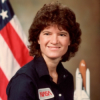Sally Ride

Sally Ride
Sally Kristen Ridewas an American physicist and astronaut. Born in Los Angeles, she joined NASA in 1978 and became the first American woman in space in 1983. She remains the youngest American astronaut to have traveled to space, having done so at the age of 32. After flying twice on the Orbiter Challenger, she left NASA in 1987. She worked for two years at Stanford University's Center for International Security and Arms Control, then at the University of California, San...
NationalityAmerican
ProfessionAstronaut
Date of Birth26 May 1951
CityLos Angeles, CA
CountryUnited States of America